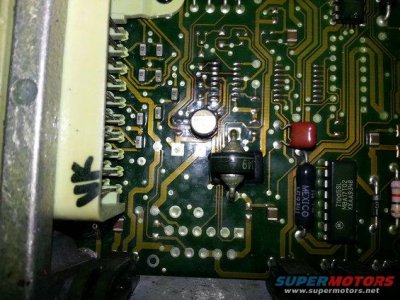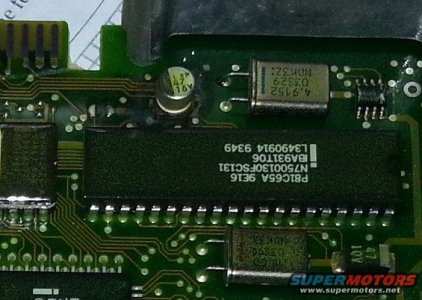Yo
DTC 512 "...indicates the PCM has experienced a power interrupt in its Keep Alive Memory (KAM) circuit. If KAPWR is interrupted to the PCM, for example when installing a breakout box, or when battery is disconnected, DTC 512 may be stored in Continuous Memory. Key off. Disconnect Powertrain Control Module (PCM). Inspect for damaged or pushed out pins, corrosion, loose wires, etc. Service as necessary. Install breakout box, leave PCM disconnected. Measure voltage between Test Pin 1 and Test Pin 40 or 60 at the breakout box. While observing DVOM, grasp the EEC-IV harness and wiggle, shake or bend a small section while working from the PCM to the dash panel. Does DVOM indicate less than 10.5 volts? Make sure you have a good ground at G101 (Passenger of engine compartment, near battery). If so I think I would go ahead and change the PCM as I do not know of any thing else out side the PCM to cause this..."; Source: by subford
Inspect PCM...
Open EEC and look for leaky/burnt capacitors.
Capacitor Repair in a 90 5.8
Source: by dolittle (seedpress) at Fuel Pump Runs But Engine Won't Start
"... finally pulled the computer and, sure enough, two of the electrolytic capacitors had leaked. Not only were they shot, but the leaked electrolyte had begun corroding some pins on one of the semiconductors. The computer board is covered with a conformal coating to protect it against moisture and contamination, but the electrolyte had also seeped under or through that coating and discolored the board in places.
First I cut out all three of the electrolytic capacitors, although only two of the three had leaked. Then I tried to clean the spilled electrolyte. To remove the corrosive electrolyte I had to strip off the conformal coating where I saw board discoloration. I tried to clean the affected areas with rubbing alcohol, dilute acetone (used for finger nail polish remover), and WD-40. Also, one logic IC (integrated circuit) had three pins that were corroded by the electrolyte. I tried as best as I could to clean them mechanically.
The two leaking capacitors were 47uF 16V, and the third a 10uF 63 volt. I didn't have these values on hand, but coincidentally I had just bought a hundred 22uFs with a 63V working voltage. So by paralleling two of the 22s I was able to get 44uFs, and in series I got an 11 uf. Electrolytic caps have a wide tolerance range anyway, so I hoped that would be good enough. The one problem was all the original caps were 105 C temperature, whereas my replacements are only 85 C. But my computer is behind the driver's kick panel, instead of in the engine compartment. So, I am hoping it will work, at least for a while.
It was a pain to replace the caps! First, I found it difficult to solder the new, "paralleled" capacitors to the printed circuit board. Then, I wasn't sure how many layers the board had -- it's easy to overheat and ruin underlying layers. Finally, some of the copper pads to which the new caps were being soldered were also very close to fine-pitched copper traces. My finished "repair" is a real mess! But it seems to be working.
'90 Bronco EEC Interior Photo by dolittleproject @
'90 Bronco EEC Interior Photo by dolittleproject | Photobucket
...


Some pics by jowens
*******
MIESK5 NOTE, as I mentioned in another thread here; In place of the breakout box, go to the EEC CONNECTOR's pin(s) instead
Ensure battery is fully charged
Run the engine at 1500 rpm with no electrical load.
Read the voltage. The voltage should be in the range of 14.1 to 14.7 volts.
Pin 1 is KA PWR – Keep Alive Power
Pins 40 is Ground
Pin 60 is Ground

The Keep Alive Memory (KAM) within the processor must always have voltage supplied to it. This voltage is supplied by the Keep Alive Power (KAPWR) circuit (Pin 1) that connects directly to the battery. KAM contains adaptive parameter tables that allow the processor to adapt to different operating requirements. It also contains the Continuous Memory codes. Continuous Memory codes will be erased any time KAPWR is disconnected (i.e. battery disconnected, processor disconnected, breakout box installed, open in the wire, etc.). If KAM fails within the processor, all Continuous codes will also be erased.
&
Also caused by;
Battery terminal corrosion
KAPWR to PCM interrupt/open
Loose battery connection
Damaged PCM (less likely)
...basically, if the truck is running fine, don't worry.



